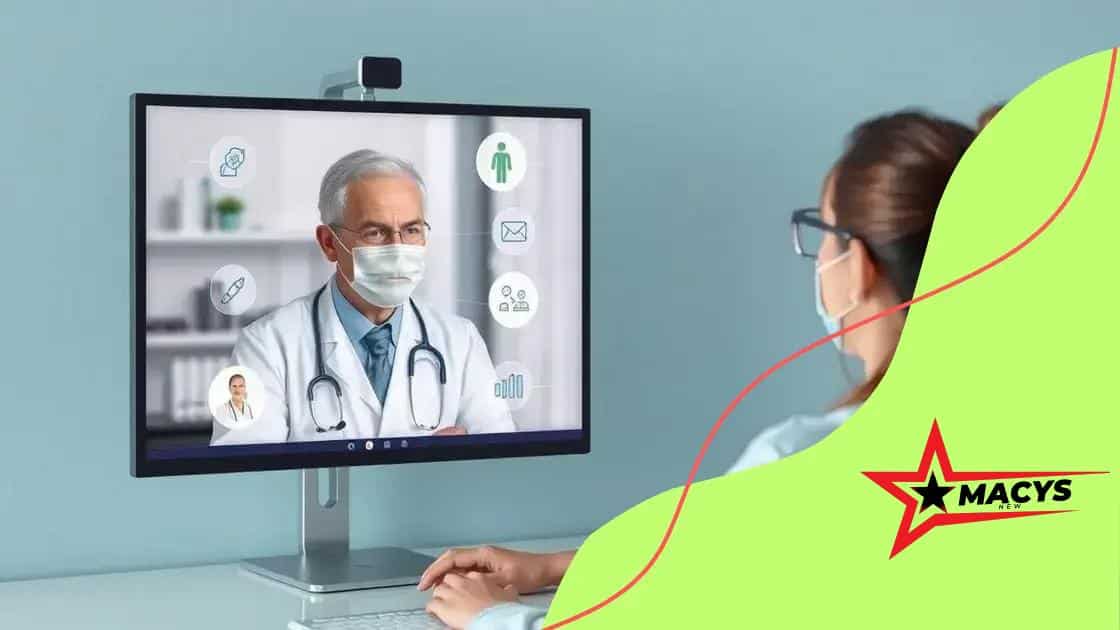Benefits of telemedicine services under public programs

The benefits of telemedicine services under public programs include increased healthcare accessibility, cost savings for patients, and improved patient outcomes through ongoing virtual consultations and care.
Benefits of telemedicine services under public programs are transforming healthcare access for many people. Have you ever considered how these services can make healthcare more reachable and efficient? Let’s dive in.
Understanding telemedicine and its growth
Understanding telemedicine is key to grasping its role in modern healthcare. This technology has grown rapidly, especially in recent years, enabling patients to receive medical care from the comfort of their homes. Have you ever wondered how this shift benefits both patients and healthcare providers?
The growth of telemedicine
Telemedicine began as a way for healthcare professionals to monitor patients remotely. Today, it encompasses much more, including virtual consultations and follow-up appointments. With advancements in technology, telemedicine services are increasingly becoming mainstream.
Benefits of telemedicine services
- Increased accessibility: Patients in rural areas can access specialists without traveling long distances.
- Cost-effective: Telemedicine can reduce costs for both patients and healthcare facilities.
- Convenience: Patients can schedule appointments that fit their busy lives, reducing missed appointments.
- Improved quality of care: Healthcare providers can monitor patients more closely and adjust treatments in real time.
As telemedicine continues to evolve, its integration into public healthcare programs is becoming more prevalent. This integration helps ensure everyone has access to essential health services. With public programs supporting telehealth, many people can overcome barriers they might face in accessing traditional healthcare.
Its benefits extend beyond just convenience and cost; telemedicine empowers patients to take control of their health. Regular check-ups and easy communication with healthcare professionals can lead to better health outcomes. Moreover, telemedicine services offer a variety of options, from mental health therapy to routine check-ups, adjusting to the diverse needs of patients.
Key benefits of telemedicine services
The key benefits of telemedicine services make a significant difference in how healthcare is delivered today. By allowing patients to connect with healthcare providers remotely, telemedicine enhances accessibility and convenience for many.
Accessibility
One of the biggest advantages is increased accessibility. Patients living in rural or underserved areas now have the opportunity to consult with specialists without the need for long travels. This means more equitable access to healthcare for everyone.
Cost Savings
Another major benefit is cost savings for both patients and healthcare systems. Telemedicine can reduce overhead costs and eliminate transportation expenses for patients. This makes healthcare more affordable, especially for those with limited financial resources.
- Reduced travel costs: Patients save money on transportation.
- Lower healthcare costs: Avoiding unnecessary hospital visits saves money.
- Insurance coverage: Many insurance plans now cover telemedicine services, further reducing costs.
Moreover, telemedicine offers unparalleled convenience. Patients can schedule appointments that fit into their busy lives, avoiding long waits at clinics. This flexibility helps enhance patient satisfaction and adherence to care.
Moreover, telemedicine services contribute to improved patient outcomes. Regular follow-ups and easy communication with healthcare providers help in monitoring health conditions effectively. This means that treatments can be adjusted promptly based on patient feedback and continuous assessment.
How public programs support telemedicine

How public programs support telemedicine highlights the crucial role these initiatives play in expanding telehealth services. Governments and organizations create frameworks that make telemedicine accessible and affordable for all.
Funding and Resources
Public programs provide vital funding to healthcare providers to adopt telemedicine technologies. This financial support allows clinics, especially in underserved areas, to upgrade their systems and improve patient care. Additionally, resources and training are offered to help providers effectively use these services.
Policy Development
Public programs also work on developing policies that facilitate the integration of telemedicine into everyday healthcare practices. By setting regulations and guidelines, they ensure that telehealth services are safe, effective, and available to everyone.
- Medicare and Medicaid: These programs include telehealth services in their coverage, allowing patients to access care without the burden of high costs.
- State-Level Initiatives: Many states have adopted policies to promote telemedicine, broadening the scope of services covered and eliminating barriers.
- Public Health Campaigns: These campaigns educate citizens about the availability of telemedicine, encouraging them to utilize these services for better health outcomes.
Moreover, some public programs focus on supporting technological infrastructure, ensuring high-speed internet access in rural and underserved communities. This access is fundamental for effective telemedicine, as it allows patients to connect with healthcare providers seamlessly.
The collaboration between public programs and healthcare providers fosters innovation in telemedicine. By working together, they can explore new technologies and methods to improve patient care, transforming the healthcare landscape.
Challenges in implementing telemedicine services
Challenges in implementing telemedicine services can significantly affect how effectively these technologies are used. While telemedicine has many benefits, various obstacles still need to be addressed for successful integration into the healthcare system.
Technological Barriers
One of the most pressing challenges is the technological infrastructure. Not all patients have access to reliable internet connections or the necessary devices. This digital divide affects rural and underserved communities the most, where access to telehealth services can be severely limited.
Regulatory Issues
Regulatory barriers also pose a significant challenge. Different states have varying regulations regarding telemedicine, which can make it difficult for healthcare providers to offer consistent services. Navigating these regulations requires time and resources, which can be overwhelming, especially for smaller practices.
- Licensing requirements: Providers may need separate licenses to practice telemedicine in different states.
- Reimbursement policies: Some insurance plans may not fully cover telemedicine services, creating barriers for patients.
- Legal considerations: Concerns about privacy and data security often complicate telemedicine adoption.
Another substantial challenge is the resistance to change among both healthcare providers and patients. Some providers may be hesitant to adopt new technologies, preferring traditional in-person visits. Similarly, patients may be unsure about how to use telemedicine platforms or may not feel comfortable with virtual consultations.
Effective training and education are essential to overcome these hurdles. Providing healthcare professionals with the necessary training can help them feel more confident in using telemedicine tools. Simultaneously, educating patients on how telemedicine works can increase acceptance and utilization, improving their overall health experience.
Future of telemedicine under public health initiatives
The future of telemedicine under public health initiatives looks promising, with significant advancements expected to enhance healthcare access and delivery. As technology evolves, so do the possibilities for telehealth services, making them a vital part of public health strategies.
Integration with Health Systems
One key aspect is the integration of telemedicine into existing healthcare systems. Public health initiatives are developing frameworks that allow seamless connections between in-person and virtual care. This provides a continuum of care that meets diverse patient needs.
Expansion of Services
Moreover, the scope of telemedicine services is likely to expand. We can expect an increase in specialties available through telehealth, including mental health, chronic disease management, and preventive care. This growth will cater to a larger population and encourage regular health check-ups from home.
- Remote monitoring: Utilizing wearable technology to track patient health data will become more common.
- AI and analytics: Advanced data analysis will help tailor healthcare solutions to individual patients.
- Community outreach: Public health programs will use telemedicine to reach underserved populations effectively.
Furthermore, legislative support for telehealth is growing. As more states recognize its benefits, policies are being crafted to expand telemedicine coverage and ensure that reimbursement for these services is fair and accessible. With this legislative backing, patients will feel more confident in utilizing telehealth options.
Public awareness and education will also play a crucial role. Efforts to inform communities about telemedicine services and how to access them will drive usage and acceptance. Understanding how to navigate these services is vital, especially for older adults and those with limited technology experience.
FAQ – Frequently Asked Questions about Telemedicine Services
How has telemedicine improved healthcare access?
Telemedicine allows patients, especially in rural areas, to consult with doctors remotely, essential when travel is difficult or costly.
What are the main benefits of telemedicine?
Key benefits include increased accessibility, reduced costs, and improved patient outcomes through regular follow-ups.
What challenges does telemedicine face?
Challenges include technological barriers, regulatory issues, and resistance to adopting new practices among patients and providers.
How can public health initiatives support telemedicine?
Public health initiatives can provide funding, develop policies, and raise awareness about telemedicine options, making it easier for people to access these services.





